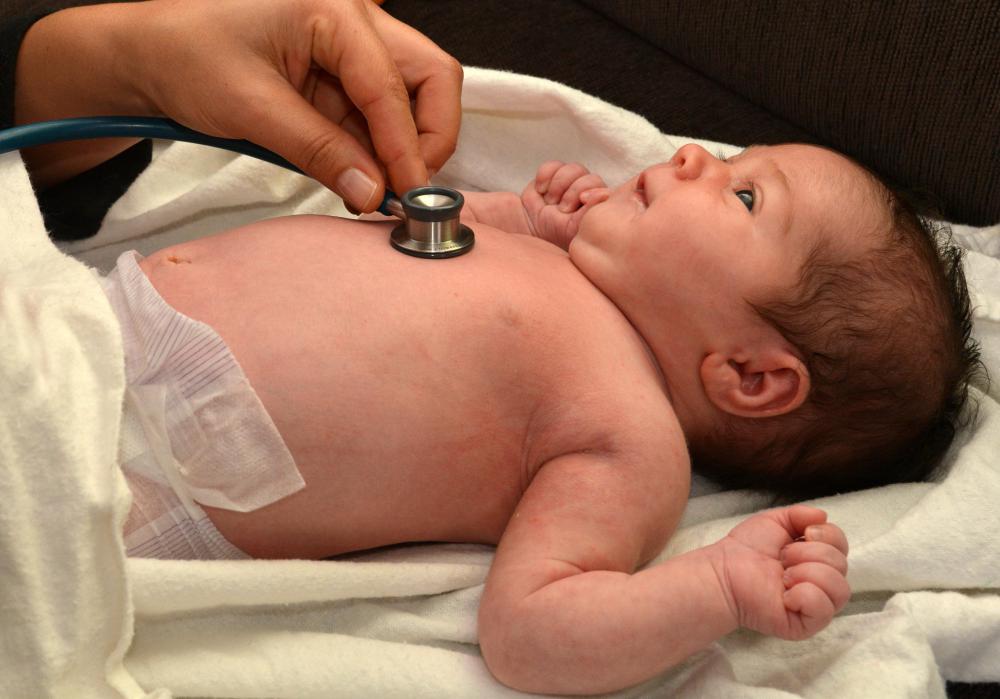At TheHealthBoard, we're committed to delivering accurate, trustworthy information. Our expert-authored content is rigorously fact-checked and sourced from credible authorities. Discover how we uphold the highest standards in providing you with reliable knowledge.
What are the Most Common Birth Defects?
The most common birth defects vary, depending on several factors including where a baby is born and its genetic descent. Some extremely common birth defects include congenital anomalies of the heart, cleft lip and palate, neural tube defects, and gastrointestinal defects. It is important for people to be aware that while some steps can be taken to reduce the risk of birth defects, such as taking vitamins in pregnancy, not all defects are preventable. Prenatal care can help parents identify, address, and prepare for abnormalities of development before the baby is born.
When looking at statistics regarding birth defects, there are a number of factors to consider. Some populations are at higher risk for congenital anomalies that occur as a result of problems with fetal development because of environmental exposure to toxins, poverty that limits access to prenatal care, and their environment. Genetics can also play a role; people of Jewish descent, for example, are more prone to certain genetic conditions. Worldwide, frequency of birth defects is highly variable and different countries experience different rates.

In the United States, the Centers for Disease Control and Prevention have identified heart defects as the most common form of birth defect, occurring in around 1% of babies. Neural tube defects involving the spine and brain are seen in .1% of the population, while cleft lip and palate occur in one in 700-1,000 babies. Other common birth defects include musculoskeletal disorders, metabolic conditions, abnormalities of the eye, and defects in the digestive tract. These birth defects are primarily the result of developmental anomalies.

Genetic disorders occur at varying rates in the population. Some are extremely rare, with only a few documented cases in the entire population. Others, such as chromosomal abnormalities, are relatively common and can be seen in a higher percentage of the population. Genetic disorders are influenced by the age of the mother, as well as the parental genetic history. Screening for defects, including genetic disorders, includes prenatal ultrasound and testing such as chorionic villus sampling.

Another thing to be aware of when examining statistics about birth defects is that anomalies present at birth can be of varying severity in different people. Some heart abnormalities, for example, are fatal, while others are so mild that they may not be discovered until several years have passed. This variance in severity can also lead to variance in statistics because researchers may use different cutoff points when compiling statistics.
AS FEATURED ON:
AS FEATURED ON:














Discussion Comments
How easy is it for doctors to discover birth defects before a baby is born? And if they do discover them, is there anything that can be done to fix the defects before birth? Or is there anything they can do to stop them defect from becoming worse?
I've heard many stories about babies who were whisked away from the delivery room to have surgery to fix something wrong. I'm just wondering if anything can be done before reaching that point.
Knowing that there are all of these different types of birth defects can be a very scary and overwhelming thought to a pregnant woman. When my friend was pregnant for the first time, she was terrified at the thought that anything could be wrong with her baby.
I completely understood her fears, but it helps though to really look at the numbers. The most common birth defect in the U.S. only occurs in one percent of babies. If you consider the enormous number of babies that are born in this country, it shows how low the odds are.
How I coped with this thought during my own pregnancies, and what I tried to help my friend do, was to not worry about what could be wrong. You shouldn't worry about something imagined, because most of the time it doesn't become a reality. I just tried to enjoy my pregnancies, and decided I would only worry if I was told there was actually something wrong.
If 1% of babies in the U.S. are born with heart defects, yet some heart defects in some people are so mild that they are not diagnosed for years, it makes me wonder if the number is actually much higher than 1%. Maybe we just don't realize it.
I wonder what it is that causes this birth defect to be the most common one in the U.S.? Is it something we are doing, exposing ourselves to, or eating? Or is there no known reason for it?
If there is a known reason, I would be interested to find out what it is. Heart defects can be a very scary thing, and I would do everything I could do avoid my children having one.
Post your comments